The second supporting question, “How did sedentary tribal nations, like Mandan, Hidatsa, and Arikara, build communities?” helps students use sources to unwrap the context of the time and topic being examined. Complete the following task using the sources provided and additional library and internet resources to build a context of the time period and topic being examined.
Formative Performance Task 2
Use the information from Featured Sources A-J, and additional sources from library and internet research, to write a summary of what life was like for sedentary village and farming tribes. How did they establish communities? Look at the documents that Densmore created as she collected songs. Listen to the Little River Women song. Today we listen to music on TV and radio. Does music have the same role in today's world as it did in Scattered Corn's community? How did Frances Densmore know that the songs she collected were accurately sung to her? Why is it important to know the songs people sang in the past? What does this song contribute to our knowledge of North Dakota history? How do we know? What else can you find?
Featured Sources 2
The sources featured below are primary sources. They are the raw materials of history—original documents, personal records, photographs, maps, and other materials. Primary sources the first evidence of what happened, what was thought, and what was said by people living through a moment in time. These sources are the evidence by which historians and other researchers build and defend their historical arguments, or thesis statements. When using primary sources in your lessons, invite students to use all their senses to observe, describe, and analyze the materials. What can they see, hear, feel, smell, and even taste? Draw on students’ knowledge to classify the sources into groups, to make connections between what they observe and what they already know, and to help them make logical claims about the materials that can be supported by evidence. Further research of materials and sources can either prove or disprove the students’ argument.
Study featured sources A-J. In a group or as a class, answer the following questions: What type of sources are they (letters, photos, maps, diaries, etc.)? What kind of information do they contain? Who created each of these sources? Who was the intended audience for each source? Why were these sources created? When were the sources created? What do the sources tell us about how a community developed in a village? How do we know? What else can you find?
Many Native American tribes have social organizations that have different kinds of functions. Traditionally, men’s societies were often associated with hunting or war while women’s societies were religious or social. Among the Mandan, men and women joined societies appropriate for their age group. Young women, in their teens, could join the Little River Women society. Older women joined the Goose Society, and elderly women belonged to the White Buffalo Calf Society. When young Mandan women joined the Little River Women society, they exchanged gifts with older women, who were in their twenties, for the right to membership in the society. Several years later, as they were adult women in their twenties, they would receive valuable gifts in turn from younger women seeking to join the society. They would pass their membership on to a young woman and join the next level of society for their age group.
In the early 20th century, ethnomusicologist Frances Densmore recorded the songs of the Mandan and many other tribes. She was educated in music at Oberlin Conservatory. She became interested in the musicology of Indian tribes and began her study in 1905 with the music of the Ojibwe of Grand Marais and Grand Portage in Minnesota. Over the course of decades, Densmore recorded Native American music on more than 2,000 wax cylinders, including songs of the Chippewa, Mandan, Hidatsa, Arapaho, Cheyenne, Papago, Pawnee, Seminole, Sioux, and others. Her collaboration with Scattered Corn, a Mandan woman from the Fort Berthold Reservation (also known as Mrs. Holding Eagle), and many others allowed her to build awareness of Native American music. She wanted people to know Native American music was more than the stereotype of the heavy drum or tom-tom beat that was used to represent such music in popular culture media including movies. She worked with the Smithsonian Institution to collect and publish her studies and eventually published twenty books and more than one hundred articles about Native American music. Scattered Corn was born in the middle of the 19th century, the daughter of Moves Slowly, who was the last Mandan corn priest. Her mother was Medicine Seed, who taught Scattered Corn to build a proper earth lodge. During her lifetime, Scattered Corn built three earth lodges for her own use. In 1929, with funding from the State Historical Society, she built an earth lodge on the state capitol grounds in Bismarck. The Densmore sources are from collection SHSND Mss 0335.
| Source A |
Little River Women Society 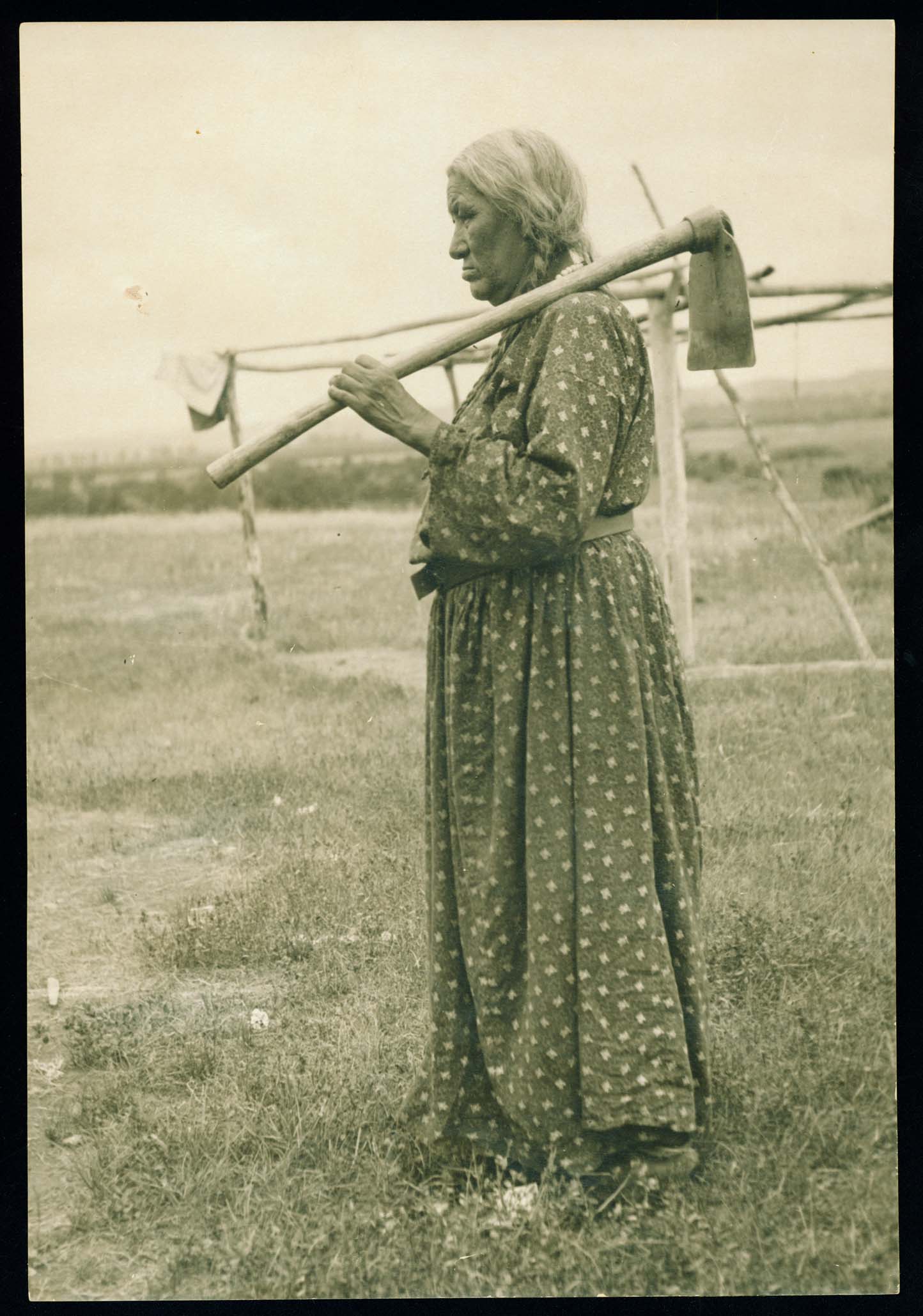
Scattered Corn standing with hoe. SHSND D0566-1. |
| Source B | 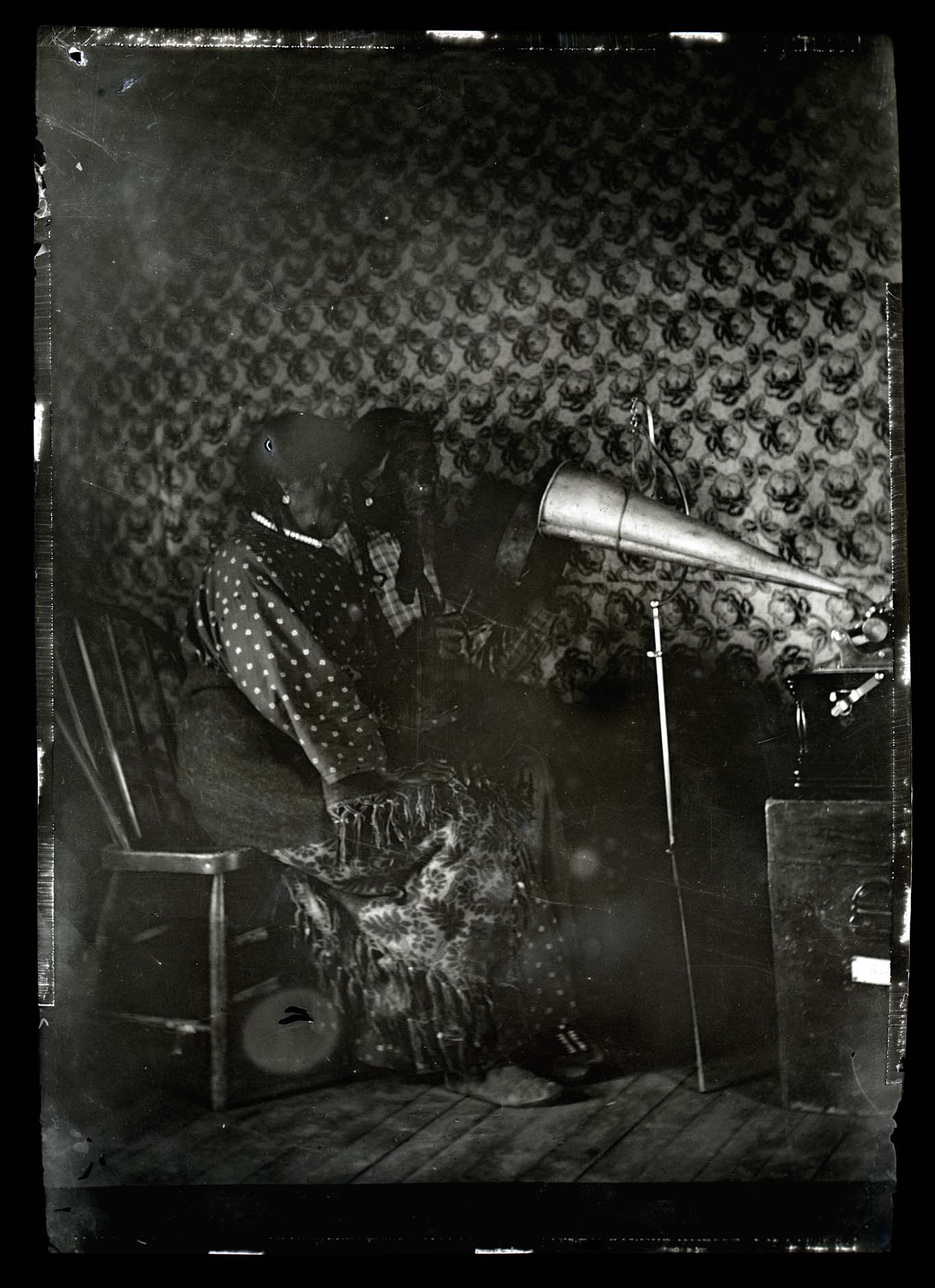
Little Crow and his wife recording on a Victrola. SHSND 0270-099. |
| Source C | 
Reverend Dr. Charles Hall, Mrs. Crow’s Heart, Frances Densmore, and Crow's Heart, 1915. SHSND 0086-1305. |
| Source D | 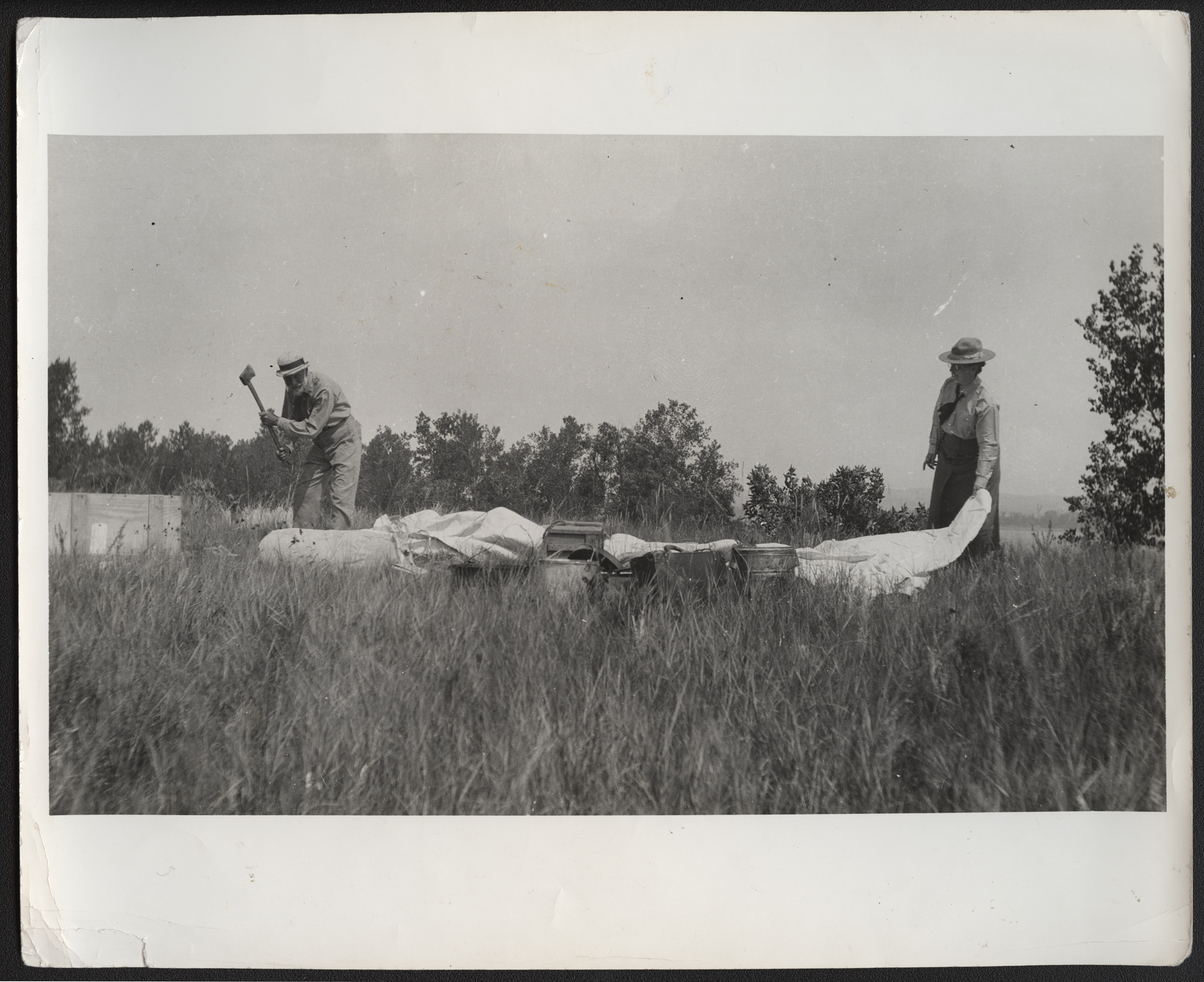
Dr. Charles Hall and Frances Densmore making camp near Crow’s Heart’s Place. SHSND 0035.01174. |
| Source E |
Field Notes 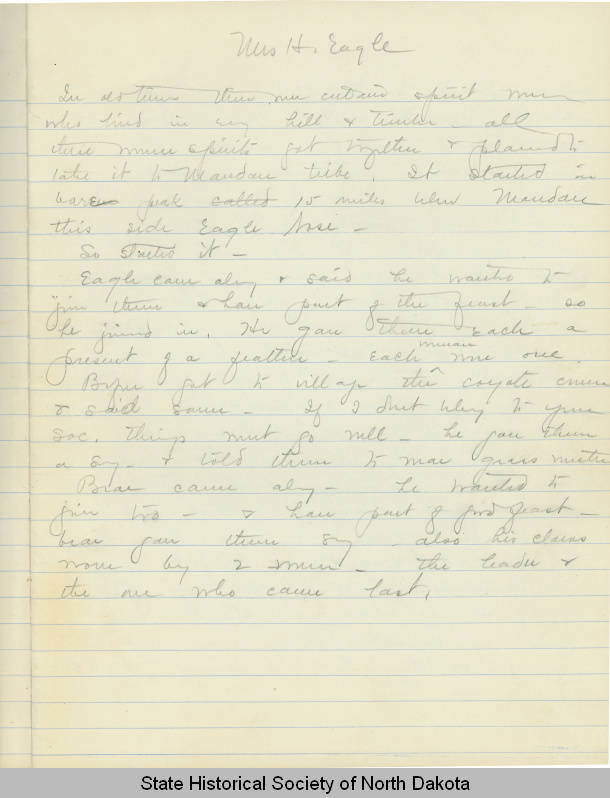
http://www.digitalhorizonsonline.org/digital/collection/uw-ndshs/id/3119 |
| Source F |
Typewritten Transcript Densmore then typed up her notes. Though these notes tell more about the song, they are still incomplete. She added to her typewritten notes as her understanding of the song’s ceremonies and history became clearer to her. She interviewed several people over a period of three years (1912–1915) to be sure that her understanding was correct. Source: SHSND Mss 10335. Mrs, Holding Eagle In Olden times there were certain Spirit Women who lived in every hill and timber. All these Spirit women got together (made up a society or ceremony) and planned to take it to (the) Mandan Tribe. It started on (a) bare peak 15 miles below Mandan this side (of) Eagle Nose So started it- (The) Eagle came along and said he wanted to join them- and have a part of the feast. He gave them each a present of a feather. Each woman wore one. Before (they) got to the village the Coyote came and said to them. If I dont belong to your society things wont go well. He gave them a song and told them to make grass wreaths. Bear came along, he wanted to join too and have part of the feast. Bear gave them a song also his claws Bears claws) worn by two women, the leader and the one that came last. They just made one trip next day [and] got to village. These spirit women came to (the) village and when (they) entered. Their feet didnt touch (the) ground. They told every young maiden to get food (and help) start this Society. I bring this Society to you because you are people of(the ) Missouri (River).(They) took (the) things(the maidens brought) with (them into a) certain lodge sat around (and) ate. Because they were spirit women they didnt talk aloud, Just whispered. Took off their head-dresses [of] grass and laid them down. Then had a feast and taught songs to (the) maidens, and sang all songs given by (the) Spirits. They were easy to learn, so they learned them all at that one time. The Spirit women showed the head-dresses to the maidens and told them to make some like them. These Spirit women had snakes around their heads, but said instead of snakes you can braid grass and wear it in your head-dress. When they had given this Society to (the) maidens they went away. Since (that time) the older women give it to the younger women She (probably Mrs. Holding Eagle) was one who wore (a) bear necklace at time of Ceremony, the older women made head dresses and sold it -with right to make and sell others at value of horse or buffalo robe, the head dress was thrown away after the ceremony but the buyer could make a new one next year. Mrs. Holding Eagle sold this right to Mrs. Sitting Crow Then they came in (to the village) Often they went around in (the) open space in (the) middle of the village making head-dresses and singing Bear – Shell-said Coyote-said I am When they came where Bear and Eagle came to Creek, and a shell said I want to join too So (they) used shell for (a) necklace. Green water Snake wanted to join, which was reason for braided head-dress. 2 -only- wore shell, but were not same who wore-'1 bear claws After two villages united in the Ceremony there were four wearing shell and claws The right to wear claws and shell was handed, down by an older woman to her Neice- never daughter - She joined the Society when 16 (Mrs. Holding Eagle?) |
| Source G |
Song Transcript 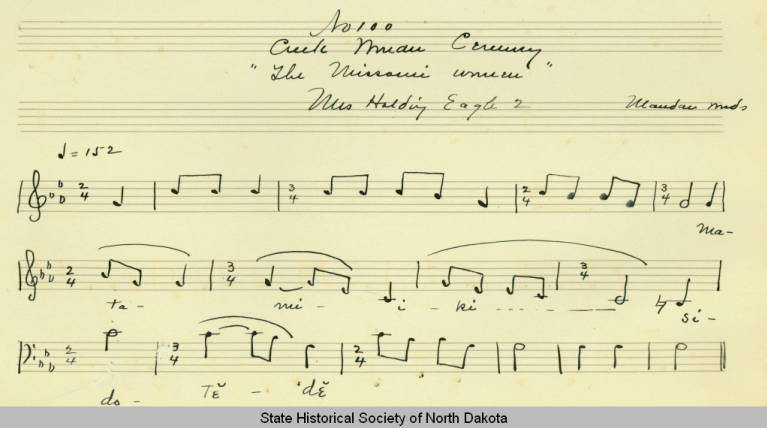
Densmore not only recorded the songs, but transcribed the music including the notes and the rhythms of the accompanying drums. Later these handwritten transcriptions were published in one of her many books and bulletins. Densmore listened to this song several times to be sure that it was presented to her consistently. She recorded The Missouri Women song in 1912 and 1915. Here you can listen to the 1915 version sung by Scattered Corn. Densmore made the original recording on a wax cylinder. Later the recording was transferred to audio tapes. Wax cylinders record only two minutes of music. With an introduction, the song is 3:01 minutes long. |
| Source H |
Densmore Article |
| Source I | |
| Source J |
People of the Upper Missouri Online Exhibit The confluences of the Knife, Heart, and Missouri Rivers in North Dakota have been the home and meeting place of peoples of many cultures for thousands of years. Native American hunters made seasonal rounds following ripening plants, herds of bison and other animals, and other useful resources. This region was also a highway for native traders dealing Knife River flint, a translucent, coffee-colored stone quarried along the banks of the Knife and its tributaries to the west. This stone was widely traded throughout much of North America. Beginning about 1,000 years ago, the big-game hunting cultures were replaced by village farmers who were the ancestors of the Mandan and Hidatsa. For many generations, their villages were the focal point of an extensive trade system, which linked the largely sedentary farmers, who dealt in corn and other garden produce, with migratory tribes who dealt in weaponry, clothing, exotic raw materials, and ornaments. |


